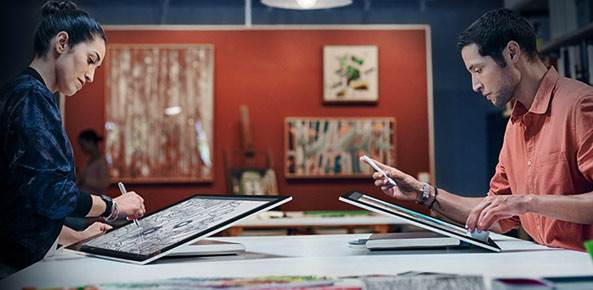
The company that helped put a computer on every desktop is taking a stab at reshaping the desktop. And, in the process, it’s trying to shift the conversation around computers toward creating and building things.
“We are the company that stands for the builders, the makers, the creators,” Microsoft Chief Executive Satya Nadella said at a Windows 10 media event Wednesday in Lower Manhattan. “That’s who we are.”
One prominent example was the introduction Wednesday of the Surface Studio, a desktop computer aimed at engineers and creative types. The 28-inch touch-screen monitor, connected to a processing base, can lie nearly flat, turning into a digital whiteboard for drafting engineering blueprints, film storyboards or other pursuits.
The device, along with a new set of coming Windows 10 features announced on Wednesday, is part of the Redmond company’s effort to keep Windows relevant amid a shrinking personal-computer market.
Nadella said advances in computing devices during the past 10 years, an era in which Microsoft struggled to succeed among technology consumers, had primarily opened up new ways of consuming media. The next 10 years, he said, would be about computers enabling new ways to create things.
Microsoft is hoping that better lines up with the company’s strengths.
Sales of PCs, home to the vast majority of Windows devices, peaked at about 353 million units sold in 2011, and have declined each year since, according to researcher Gartner. The firm expects another decline this year, to 265 million units.
Microsoft, which traditionally relied on companies like Dell and HP to build the hardware running Windows, has turned to its lineup of Surface-branded devices to drum up interest in Windows-powered hardware.
In the past five years, Microsoft has introduced a successful Surface tablet PC line, the high-end Surface Book laptop, and, on Wednesday, the Surface Studio, a resident of the all-in-one category of devices that integrate a monitor with a computing unit.
“We built it for creators; we built it for professionals,” said Panos Panay, the corporate vice president who oversees Microsoft’s hardware engineering, said at the media event. “It’s meant to transform the way you work.”
For now, those professionals are an affluent bunch. At a starting price of $2,999, the Surface Studio isn’t aimed at a mass market.
“Starving artists aren’t going to be able to afford that,” said Steven Kleynhans, an analyst with Gartner. “Microsoft is showing kind of a different reason for Windows to exist. They are really trying to play up a new message.”
The Surface Studio, available Wednesday for preorders, is expected to arrive in limited quantities by the holidays, Microsoft said.
The company also introduced a new Surface Book, a laptop that represents direct competition with Apple, long a favorite among creative types. The high-end new Surface Book, boasting longer battery life and powerful graphics processing, is priced at $2,399 and rivals the Cupertino, Calif.-based Apple’s MacBook line.
But unlike Apple, with its world-beating iPhone, Microsoft remains weak in smartphone computing.
At a similar hardware-focused event in New York last year, Microsoft introduced two new smartphones, one of the last gasps of the handset unit acquired from Nokia in 2014 and subsequently dismantled.
On Wednesday, aside from a cameo from an HP-made Windows smartphone, the world’s best-selling type of computing device was absent from the stage.
“They’re probably on to something, in terms of trying to redirect the business to their strengths,” said Stephen Baker, an analyst with NPD Group. Still, “they’re selling me a stationary computing experience in a world that wants to move,” he said of the Surface Studio.
Also on Wednesday:.
–Microsoft said its second major update to Windows 10, called the Creators Update, would be released early next year and would feature support for scanning and producing three-dimensional images. It also comes with a refreshed version of the decades-old Paint application.
–The company is diving into virtual reality. The Windows 10 update will include support for 3-D experiences, including VR. The company has brought some partners along for the ride, promising new, “affordable” virtual-reality accessories tailored for Windows and built by HP, Dell, Lenovo, Asus, and Acer.
Microsoft says the cheapest of those coming devices will start at $299, cheaper than the new generation of high-end VR devices, including Facebook’s $599 Oculus Rift and the HTC and Valve-built $799 Vive.
The high-end universe also includes Microsoft’s HoloLens, an augmented reality headset that costs $3,000.
“Powerful and affordable virtual reality is coming to everyone,” said Terry Myerson, chief of Microsoft’s Windows and Devices group.
© 2016 Seattle Times under contract with NewsEdge. -.







